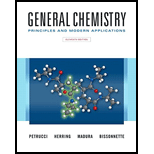
Concept explainers
The laboratory device pictured on the following page is called a desiccators. It can be used to maintain a constant relative humidity within an enclosure The material(s) used to control the relative humidity are placed in the bottom compartment and the substance being subjected to a controlled relative humidity is placed on the platform in the container.

a If the material n the bottom compartment is a saturated solution of NaCl(aq) in contact with NaCI(s), what will be the approximate relative humidity in the container at a temperature of 20 'C Obtain the solubility of NaCl from Figure 14-10 D and vapor pressure data for water from Table 12.5; use the definition of Raoult’s law from page 660 and that of relative humidity from Focus On 6-1: Earth's Atmosphere: assume that the NaCI is completely dissociated into its ions
b If the material placed on the platform is dry
c. To maintain
Want to see the full answer?
Check out a sample textbook solution
Chapter 14 Solutions
EBK GENERAL CHEMISTRY
- Fluoridation of city water supplies has been practiced in the United States for several decades. It is done by continuously adding sodium fluoride to water as it comes from a reservoir. Assume you live in a medium-sized city of 150,000 people and that 660 L (170 gal) of water is used per person per day. What mass of sodium fluoride (in kilograms) must be added to the water supply each year (365 days) to have the required fluoride concentration of 1 ppm (part per million)that is, 1 kilogram of fluoride per 1 million kilograms of water? (Sodium fluoride is 45.0% fluoride, and water has a density of 1.00 g/cm3.)arrow_forward. K for copper(II)hydroxide, Cu(OH)2, has a value 2.21020at 25 °C. Calculate the solubility of copper(II) hydroxide in mol/L and g/L at 25 °C.arrow_forwardRefer to Figure 13.10 ( Sec. 13-4b) to answer these questions. (a) Does a saturated solution occur when 65.0 g LiCl is present in 100 g H2O at 40 C? Explain your answer. (b) Consider a solution that contains 95.0 g LiCl in 100 g H2O at 40 C. Is the solution unsaturated, saturated, or supersaturated? Explain your answer. (c) Consider a solution that contains 50. g Li2SO4 in 200. g H2O at 50 C. Is this solution unsaturated, saturated, or supersaturated? Explain your answer. Figure 13.10 Solubility of ionic compounds versus temperature.arrow_forward
- What happens if you add a very small amount of solid salt (NaCl) to each beaker described below? Include a statement comparing the amount of solid eventually found in the beaker with the amount you added: a a beaker containing saturated NaCl solution, b a beaker with unsaturated NaCl solution, c a beaker containing supersaturated NaCl solution. A saturated sodium chloride solution.arrow_forward. Why does the amount of excess solid solute present in a solution not affect the amount of solute that ultimately dissolves in a given amount of solvent?arrow_forwardFor each of the following pairs of solutions, select the solution for which solute solubility is greatest. a. Oxygen gas in water with P = 1 atm and T = 10C Oxygen gas in water with P = 1 atm and T = 20C b. Nitrogen gas in water with P = 2 atm and T = 50C Nitrogen gas in water with P = 1 atm and T = 70C c. Table salt in water with P = 1 atm and T = 40C Table salt in water with P = 1 atm and T = 70C d. Table sugar in water with P = 3 atm and T = 30C Table sugar in water with P = 1 atm and T = 80Carrow_forward
- A compound has a solubility in water of 250 mg/L at 25C. Should this compound be characterized as a soluble or insoluble compound at 25C?arrow_forwardHow are the boiling point and freezing point of water affected by the addition of solute?arrow_forwardSupersaturated solutions of most solids in water are prepared by cooling saturated solutions. Supersaturated solutions of most gases in water are prepared by heating saturated solutions. Explain the reasons for the difference in the two procedures.arrow_forward
- The freezing point of a 0.21 m aqueous solution of H2SO4 is -0.796C. (a) What is i? (b) Is the solution made up primarily of (i) H2SO4 molecules only? (ii) H+ and HSO4- ions? (iii) 2H+ and 1SO42- ions?arrow_forwardTemperature influences solubility. Does temperature have the same effect on all substances? Justify your answer. (Hint: Consider Le Chateliers principle.)arrow_forwardAssume that a sample of hard water contains 50. mg/L of Mg2+ and 150 mg/L of Ca2+, with HCO3 as the accompanying anion. What mass of CaO should be added to 1.0 L of this aqueous solution to precipitate all the Mg2+ and Ca2+ as CaCO3 and MgCO3? What is the total mass of the two solids formed?arrow_forward
 Chemistry: The Molecular ScienceChemistryISBN:9781285199047Author:John W. Moore, Conrad L. StanitskiPublisher:Cengage Learning
Chemistry: The Molecular ScienceChemistryISBN:9781285199047Author:John W. Moore, Conrad L. StanitskiPublisher:Cengage Learning Chemistry: Principles and ReactionsChemistryISBN:9781305079373Author:William L. Masterton, Cecile N. HurleyPublisher:Cengage Learning
Chemistry: Principles and ReactionsChemistryISBN:9781305079373Author:William L. Masterton, Cecile N. HurleyPublisher:Cengage Learning Chemistry: Principles and PracticeChemistryISBN:9780534420123Author:Daniel L. Reger, Scott R. Goode, David W. Ball, Edward MercerPublisher:Cengage Learning
Chemistry: Principles and PracticeChemistryISBN:9780534420123Author:Daniel L. Reger, Scott R. Goode, David W. Ball, Edward MercerPublisher:Cengage Learning General, Organic, and Biological ChemistryChemistryISBN:9781285853918Author:H. Stephen StokerPublisher:Cengage Learning
General, Organic, and Biological ChemistryChemistryISBN:9781285853918Author:H. Stephen StokerPublisher:Cengage Learning Chemistry by OpenStax (2015-05-04)ChemistryISBN:9781938168390Author:Klaus Theopold, Richard H Langley, Paul Flowers, William R. Robinson, Mark BlaserPublisher:OpenStax
Chemistry by OpenStax (2015-05-04)ChemistryISBN:9781938168390Author:Klaus Theopold, Richard H Langley, Paul Flowers, William R. Robinson, Mark BlaserPublisher:OpenStax Introductory Chemistry: An Active Learning Approa...ChemistryISBN:9781305079250Author:Mark S. Cracolice, Ed PetersPublisher:Cengage Learning
Introductory Chemistry: An Active Learning Approa...ChemistryISBN:9781305079250Author:Mark S. Cracolice, Ed PetersPublisher:Cengage Learning





